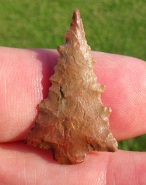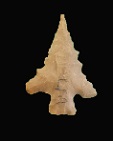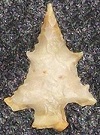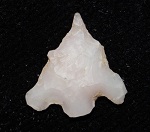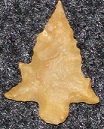Other Websites with Detailed Information:
Name Details:
Named By: J. Charles
Kelly
Named For:
Date Identified: 1947
Type Site:
This type was first identified by Kelly in 1947 calling it Steiner Serrated.
The type was described further by Perry H. Newell and Alex D. Krieger in
1949. The name was shortened and described in detail by Dee Ann Story
(Suhm) in 1965.
Steiner
Cluster:
Commonly Utilized Material:
Date:
Cultural Period:
1,100 - 500 B.P.
Mississippian / Late
Prehistoric
Medieval Warm to Little
Ice Age
Glacial Period:
Culture:
Outline is Representative of Size and Shape:
Description of Physical Characteristics and Flaking Pattern:
This is a small
triangular stemmed point with an elliptical cross section. The blade is primarily straight and has projecting spurs along the blade. Some examples have deep serrations on the blade forming the projecting spurs and may create an appearance of flaring shoulders. The shoulders are prominent and
may range from horizontal to slightly barbed. The stem may vary from straight to slightly expanding with a straight to slightly concave base. This point has a random flaking pattern.
Size Measurements: Total
Length - 18 to 45 mm, Stem Length - 4 to 6 mm, Blade Width - 10 to 27
mm, Stem Width at Shoulders - 5 to 8 mm
Distribution:
Distribution Comments:
This point is primarily found in eastern Texas and into southwestern Arkansas. This point may be found into southeastern Oklahoma and western Louisiana with decreased frequency.
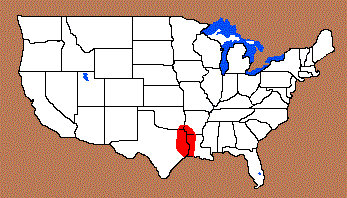
Additional Comments:
Turner and Hester (1985) argue that this is the same type as the Rockwall type. The two types may be the difference between the serration patterns on the blade. This type has
more protrusions and the Rockwall is more serrated.
Davis (1995) notes that “The Steiner point and the Friley point are probably
the most similar in general outline.” with the primary difference being that
the “Friley type has strong barbs that usually curve upward toward the
distal end which distinguishes it from the Steiner point.” (Moore, 2015)
Other points in this Cluster:
Point Validity: Valid Type
Kelley was a distinguished
anthropologist who served as Curator of the Archaeological Museum at the University of Texas-Austin and was instrumental in setting up the Department of Anthropology at the University of Texas-Austin. He specialized in the archaeology of western Texas. This type was named in a professional publication and has many professional references. This is considered a valid type.
.
Age Details:
References: (See Reference Page, Entry Number):
8, 23, 30, 182
Steiner Projectile Point, Steiner Arrowhead
